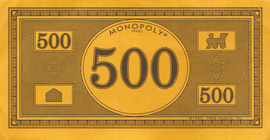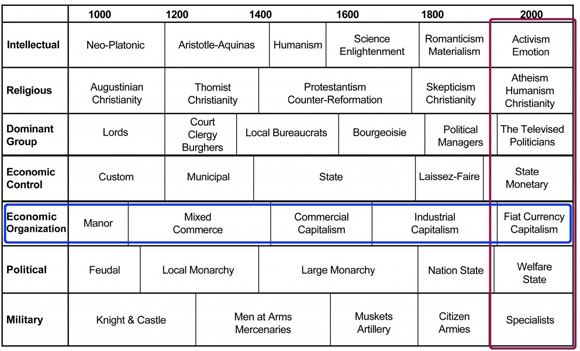By Paul Rosenberg, FreemansPerspective.com
I have worked long and hard to gather a broad perspective on history. I don’t doubt that there is value in specialization. In fact, I would have great difficulty doing what I do without good specialists.
Nonetheless, my particular set of abilities suits me to play specialist for short, intense periods, and then to integrate my gleanings into a larger whole.
One of my general conclusions has been that if we were to give a name to the last forty years of Western history, we’d have to call it the era of fiat currency capitalism. There is a contradiction built into this term, of course, since fiat currencies and capitalism are oppositional, but such an inherent contradiction is also highly representative of this period.
Having been inside of this contradiction most or all of our lives, it can seem almost permanent and inevitable to us. Nonetheless, it will end, and probably before terribly long. As Robert Louis Stevenson once wrote:
Sooner or later, everyone sits down to a banquet of consequences.
For the last forty years, things which should have crashed and burned have not crashed and burned, and it was fiat currency that permitted the consequences to be scorned. Western culture and millions of minds have been bent in the process.

Fiat versus Reality
Fiat currency is money based upon nothing at all. The Monopoly money shown above has the same actual value as the Dollars, Euros or Pounds in your pocket. For the moment, the paper in your pocket will buy you food and furniture, but not because it has any real value.
Our daily money is created by politically-favored groups who have been granted monopolies on the creation of currency. (They are referred to in polite company as central bankers.) They create our money, from nothing, and all others are forbidden from doing so. If that sounds crazy, it’s because it is.
The only people with any authority over these currency monopolists are politicians, and that isn’t terribly strong. (In the case of Great Britain, the monarch has some control as well.)
I won’t bother trying to list the ways this astonishing privilege could be abused. Feel free to play with the possibilities on your own. And do remember that more or less every dirty trick that people could get away with, they have eventually used… and bankers have never been exceptions.
This new era began in 1971, when the previous international monetary arrangements, the Bretton Woods system, fell apart. On May 5th 1971, US dollars flooded the European currency markets and threatened the Deutsche Mark. The central banks of Austria, Belgium, Netherlands and Switzerland stopped all dollar trades. Who was behind this flood of trades is unknown to me but it was apparently someone with inside knowledge. At about the same time, the French were, via complex arrangements, redeeming their dollars for gold from the US Treasury, as Bretton Woods allowed. (It was gold that kept the system honest. If you thought games were being played, you could turn in your paper for actual gold.)
If the US had allowed redemptions to continue, they would have lost all their gold reserves. So, on August 15th 1971, the US pulled out of their monetary agreements and refused to redeem any more dollars for gold. (This was called closing the gold window.) Bretton Woods fell apart and, very shortly, no major currencies were redeemable; everything became fiat currency, based on government edicts alone.
This change from redeemable money to fiat currency has affected Western life immensely. For more than forty years, life in the West has been based on money with no value, which has spawned a lot of other things that have no value.
Quigley’s Chart
The chart below is my modernization of a chart used by Carroll Quigley, one of the best generalist historians of the 20th Century. The chart displays his seven primary factors of Western Civilization, and how they have varied over the last thousand years or so. You’ll notice that I’ve circled our era in red and called attention to the form of economic organization with blue.

As I’ll illustrate below, fiat currency has had significant influence, not only within the ‘Economic Organization’ category I have highlighted, but also over ‘Political’, ‘Economic Control’, ‘Dominant Group’, and even ‘Intellectual’. It has more or less defined our era. So, if I am correct that the reign of fiat currencies is ready to end… big, big changes lie in our future.
Horrific Debt
Fiat currencies allowed politicians to spend money without raising taxes. They did this by creating debt. I won’t spend time on the complex process involved, but every new Dollar, Pound or Euro that is created also creates more than its own value in debt. The currency is spent immediately but the associated debt can be pushed back indefinitely.
Faced with this situation, politicians asked their central bankers to create more and more money, which they quickly spent. Whether on social programs or wars, sensible or not, politicians spent money like there were no consequences attached.
But by spending in this way, the politicians also spent the tax receipts of future generations. Every new dollar requires the central bankers to sell more than a dollar’s worth of bonds, which are debt. This debt has been pushed endlessly toward the future… to the point where American children are now born $70,000 in debt, with five times that much promised.
All bonds are claims against future earnings. The children of the West have had decades of taxes pledged to bondholders they will never know, for money that was spent years before they were born. And, yes, it really is that bad.
The Welfare State
The debt of the Western states was spent on something, obviously, and the most notable destinations for that money were “welfare state” programs. This worked in the favor of politicians in the old, reliable way: by promising voters free stuff. And, more importantly, fiat currency allowed them to make good on those promises without raising taxes.
The most crucial fact about debt-funded welfare, however, is that it made it seem that politics could produce magic. Government was able to give massive streams of money to groups that placed ideals above reality. “Wishing makes it so” seemed to work. This corrupted the reasoning of millions of people and punished those who did hold doggedly to reason. And, this corrupting influence has continued for a long, long time.
Wall Street Contributed to the Damage
The people who work on Wall Street, and in the other financial capitals like London, tend to be aggressive and competitive. On top of that, the big financial firms place them into highly competitive situations like “the top producer gets a double bonus.” It should then be no surprise that such people would want to get in on the central banking game, and to create their own money from scratch.
Central banking need not be the only way to create money; any trusted debt can be used. Here is what Alexander Hamilton (who created central banking in the United States) had to say about this in his Report on Public Credit in 1790:
It is a well known fact, that in countries in which the national debt is properly funded, and an object of established confidence, it answers most of the purposes of money. Transfers of stock or public debt are therefore equivalent to payments in specie. [“Specie” was silver or gold.] In other words, stock, in the principal transactions of business, passes current as specie.
Hamilton’s formulation in plain words is this: Debt can be used as money, and people will accept it as money.
So, if the clever boys of Wall Street and Fleet Street couldn’t get in on the central banking game, they could nonetheless create a new version of it, by using new types of debt as money. (Though this was probably the result of many small decisions rather than one large one.)
What most people don’t know about Alexander Hamilton is that it wasn’t only American central banking that he created; he also created Wall Street. That his securities dealer descendants pursued an alternate way to create money seems almost fitting.
Wall Street’s new debt money is called derivatives. A derivative is a contract whose value is derived from other quantities. Derivatives have existed for a long time, but in the past dozen or so years the financial centers of the world have pumped out stunning amounts of them in a wide array of new configurations. All of these derivatives have their own value. It was one particular type of these financial products that seems to have started the crash of 2008.
I am not expert enough to reach any conclusion as to what specific fallout can be expected from this but $600 trillion dollars of synthetic monetary instruments have to be significant.
Indeed, it goes far beyond just money. The era of fiat currency capitalism has changed who we are in broad and disturbing ways.
[Editor’s Note: This article is an excerpt from “outside the Matrix” author Paul Rosenberg’s flagship newsletter – Freeman’s Perspective – Issue #07: The Era of Fiat Currency Capitalism. If you liked it, consider taking a risk-free test drive. Not only will you gain immediate access to the rest of the issue (which shares 5 ways in which fiat currency has changed us for the worse), but you’ll also be able to enjoy the entire archive – more than 520 pages of research on topics of importance and inspiration to those looking for freedom in an unfree world. Plus valuable bonus reports and all new issues as well. Click here to learn more.]


